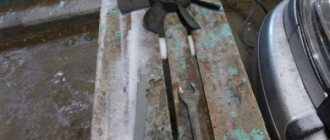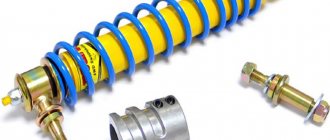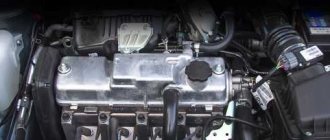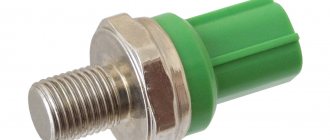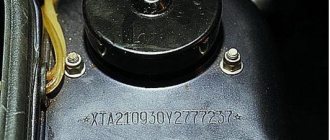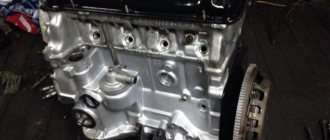What is engine demining?
Structurally, the car has a developed electrical system, in which the serviceability and accuracy of the controllers, various sensors and many other electrical devices depend on the mass. The electrical ground (minus) is connected from the battery to the car body. The body is conventionally a return wire, forming a closed electrical circuit.
The movement of electrons along the circuit is initiated by the battery, and the body acts as a conductor of negative charge for return via the negative terminal. For this reason, the metal body of a car is called car body. In this case, engine demining should be understood as a number of improvements that involve additional connection of the most powerful consumers of electricity in the car to ground.
Engine ground location
Engine mass location
In order to operate a car and carry out repair operations on it, you need to know where the mass is located. Thus, almost all devices and components of the VAZ-2114 require electrical power, and the most powerful consumers are the starter and engine .
Few people know where the ground is located on the engine, since to carry out repair operations it is enough to remove the “minus terminal” from the battery. But, during complete dismantling, and after installing the motor, you need to know where to attach the power.
So, the mass of the body is located on the metal mudguard near the battery.
Location of mass on the body
But, the negative branch consists of 2 wires: thick and thin . So, it is the thick wire that goes to the ground of the body, and the thin one to the closure of the engine circuit. Of course, not all motorists know where it goes.
The negative wire of the VAZ-2114 engine is located on the cylinder head and is attached to the tightening bolts that hold the cylinder head plugs.
Location of the VAZ-2114 engine mass
Dashboard weight
Also, on cars with the Samara-2 engine, the manufacturer began to install the mass on a welded stud, which is located in the cabin, under the dashboard.
It is she who supplies power to the engine through the mounting block. As a result, many sensors operate regardless of whether there is mass on the power unit itself.
Location of mass under the dashboard
Possible problems
The only problem in this case will be the absence or poor mass. An indicator of this problem will be stable operation of the generator and a full charge of the battery, but there will be no weight on the engine. The instrument panel may begin to increase the temperature when consumption sources are turned on. If, when you turn on the heater or headlights, the temperature on the instrument panel begins to rise sharply, then you should look for a “bad ground”.
The reason for this phenomenon is hidden in a broken wire or poor contact connections. Since these parts are affected by oxygen, they can easily oxidize.
To troubleshoot problems, you need to unscrew the power supply wire (ground) from the engine and clean the contacts. Also, it is worth inspecting the wire itself for breaks and breakdowns. Before direct installation, in order to improve the quality of the connection and delay the corrosion period, it is necessary to lubricate the contact points with copper paste.
Why do they do the de-mining?
During the operation of the car, you may encounter the fact that the electrical on-board network literally “sags,” especially at times of peak loads (simultaneous activation of the dimensions, low and high beam headlights, various heated mirrors and windows in parallel with the use of the air conditioning system, electric windows, powerful acoustics and other devices).
Also, voltage dips can occur for no apparent reason, affecting the stability of the internal combustion engine, its ignition system, ECU, sensors, servos and other electrical devices. This can happen if oxidation has occurred in the place where the negative terminal is normally attached to the body, the contact has broken down, or corrosion has appeared. The automobile electrical network naturally begins to operate unstably.
In the first case, additional demining of the engine is often necessary due to the fact that the car body is old, the standard place for attaching the mass has become unusable, etc. Regarding improvements and tuning, there is an opinion that additional de-mining allows a more even distribution of electricity in the vehicle’s on-board network compared to using the standard negative terminal.
What is included in the electrical circuit?
Regardless of whether the ignition circuit in your VAZ 2106 is contact or contactless (BSZ), the electrical circuit of the vehicle includes the following components:
It should be noted that the electrical circuit of the VAZ 2106 car with or without BSZ was initially designed taking into account the single-wire type of connection of electrical equipment components. In essence, this means that the negative contacts of electrical equipment are brought to ground, that is, the vehicle body. As for the wired connection, it is provided exclusively by positive wiring.
Additional Weight: Benefits
Engine demining for the purpose of improvement has both supporters and opponents of this method. Skeptics consider this solution a waste of time and money, citing the fact that standard solutions in the car are quite sufficient, the cross-section of the factory wires is sufficient, each sensor has its own separate negative ground (sensor ground), etc.
The main argument among those who have already implemented the procedure is the stability of spark formation and operation of the entire ignition system as a result of the most efficient and reliable mass in the car. It is also claimed that the mass becomes even for all devices that consume electricity. Such uniform distribution cannot be achieved with standard mass, even if the terminals are cleaned regularly. The list of main advantages of power engine demining includes:
- fuel savings at a minimum level of 5-7% or more are achieved due to the fact that the generator is unloaded and the resistance is reduced;
- the starter rotates the crankshaft more actively at low temperatures at the time of start-up;
- the engine runs more smoothly and smoothly after de-mining;
- the power plant responds better to the gas pedal;
- the motor produces more power;
- the battery lasts longer and is recharged more efficiently from the generator;
- engine vibrations disappear when powerful consumers are turned on (air conditioning, increasing the music volume when using external amplifiers, etc.);
What could happen to the car due to poor ground contact?
With the electrical equipment of any vehicle, malfunctions can occur that seem to people far from electricians to be the work of evil spirits.
And the culprit of mysterious malfunctions in the electrical equipment of a motorcycle or car, in most cases, is poor contact of the negative terminals - “ground”. But let's take things in order. Many drivers know that the method of connecting electricity consumers to a power source (generator or battery) on any vehicle is single-wire. The second (negative) wire is the body of a car or the frame of a motorcycle (trike, scooter, ATV, etc.). The very idea of connecting the negative side of a power source (battery) to a steel frame or body is quite old and natural, as it can significantly simplify, lighten and reduce the cost of any vehicle.
A separate ground wire is used to connect the engine to the body or frame, since the engine hangs on rubber mounts that do not allow current to pass through, while both plus and minus are required by the starter, and, for example, by the carburetor solenoid valve. On foreign cars, especially injection ones, there may be even more consumers requiring electricity (and, accordingly, plus and minus). But the positive wires usually begin and end with quite reliable terminals, which are usually in completely sealed plastic blocks or rubber covers, but the negative wires are attached to the body or frame according to the principle “some water will find a hole.” And the body itself, in the place where the hole is drilled and the negative wire is secured, begins to rust very quickly, unless, of course, appropriate measures are taken immediately.
In addition, many do not take into account another important fact, which is known even to a novice electrician: aluminum and copper terminals cannot be connected to each other, since these metals, to put it mildly, are “not friendly” with each other, and begin to oxidize intensively. How can oxidized parts have normal contact? But I often see on the vehicles of inexperienced drivers, on the aluminum housing of the gearbox or engine head, a screwed-on copper terminal of the negative wire, which, in addition, is also washed by streams of water in bad weather.
A steel body or frame is also not friendly with copper, like aluminum, and forms an electrochemical couple. And the saddest thing about this is that the steel in such a connection will be blown away by two people and will corrode several times faster. As a result, the contact disappears (or there is a significant loss of current). Standard terminals installed at the factory are usually tinned. But under a thin layer of tin, which is easy to tear off when installing the terminal, there is still the same copper alloy.
Based on the above, it is obvious that the negative connections themselves to the body or frame are initially less reliable than the copper wires themselves and their copper terminals (tips). Now imagine, for example, in order for electricity to reach the carburetor solenoid valve, the electric current must go along a copper wire (copper bus) from the battery to the body, then along another wire to the engine, then along the intake manifold studs and their threads, often coated with sealant (or the studs are rusty), and finally go along the threads of the solenoid valve itself. Loss of contact in any of the listed places - and the circuit is open, and hence a whole bunch of malfunctions. As a result, the inexperienced driver is surprised - why did the carburetor suddenly begin to work poorly and gasoline consumption increase? You need to go to a carburetor specialist or buy another carburetor. But usually few people know that in such a situation the carburetor has nothing to do with it. And I gave one example of a sudden malfunction, but there can be many of them.
Therefore, in modern cars or motorcycles, full-fledged negative wires are increasingly used, because modern on-board electronics will not work without them, and most devices or programs will fail. On such equipment, reliable contact is especially important. Experienced electricians know, and I have already said this: in electrics there are only two faults - there is a contact where it is not needed, and there is no contact where it is needed.
Typical malfunctions on a car due to poor ground contact (but not all, we read about the rest below) .
These malfunctions, as I already said, seem like miracles to inexperienced drivers. It is not uncommon at a factory (especially a domestic one) to place the negative terminal of the headlight on a stud or bolt securing the headlight housing to the body, and then tighten it with a nut. At first glance, many will think that everything is correct, because the stud or fastening bolt is welded to the body. But the headlight housing is made of soft plastic, and the nut on the terminal cannot be tightened properly, otherwise the plastic will crack. In the end, it only takes a short drive on our roads to weaken such contact to the point of its complete absence. But in a standard headlight with a modest lamp of 55-60 watts, the current consumed even by such a lamp is quite large - up to 10 amperes (if both its threads are energized, both high and low beam).
In the end, a bad contact, if it does not disappear completely, will burn out, the resistance of such a connection will increase even more, and from a school physics course we know that the greater the resistance, the more heat is released when current passes in this place. This means that the burning of contacts will intensify even more (a vicious circle), and it’s not far from a fire (plastic burns well). And many young novice drivers, instead of a standard 50-60 watt lamp, install a hundred (100 watt), which consumes even more current. The consequences can be dire.
How to de-minus the engine yourself
The procedure involves running additional wires to ground from the main sources of current consumption. For most cars, the minus is carried out from 4-6 sources:
- minus generator;
- mass from starter;
- negative wire from the engine (preferably at least 2 points);
- weight of the gearbox (if automatic transmission is available);
- minus the body in the engine compartment (remote part from the battery);
- Wires must be flexible, made of high quality pure copper with a minimum content of impurities. The use of wiring based on copper alloys is not recommended.
- Also, the wire must have a large cross-section. This is necessary to ensure the best conductivity of electrical current.
- Additionally, you will need to pay attention to the insulation of the wires. It must be durable, resistant to mechanical wear and have the ability to withstand significant temperature fluctuations (large heating in the engine compartment followed by cooling).
It is worth adding that you can purchase both ready-made solutions for sale and do the demining of the engine yourself. For manufacturing you will need a copper cable, heat shrink tubing and terminals. The length of the cable and the number of terminals will depend on how many devices are planned to be grounded to the body (connected to ground). After cutting the cable, you need to crimp the terminals and apply heat shrink in those places where the cable is exposed to connect to the terminal. The final stage will be the installation of the manufactured wires in the engine compartment of the car.
How does the engine start button work? Available options and solutions for installing the starter button yourself. How to install the engine start button yourself.
Signs of malfunction or breakdown of the high-voltage spark plug wire of the ignition system. How to check car armored wires with your own hands.
The starter clicks and/or buzzes, but the engine does not turn over. The main causes of starter failures, diagnosing and troubleshooting them yourself.
How to quickly start the engine with a discharged battery. Features and advantages of using an autonomous battery charger. Tips for choosing a booster.
Conditions for proper storage of a car battery. Removing, inspecting and preparing the battery. How to preserve your battery without regular recharging.
Lada 2115 ✯Caℓifornia Poppy✯ › Logbook › ☑Additional+weight - Genuine, Body, Akb
Hi all! I'm tired of voltage drops when turning on any consuming devices. A year ago the charge was 11.2-11.5 no more when the devices were turned off
, not to mention the ones that were turned on...
I installed new Gena brushes, the charge became 12.3-12.6-13.2
.
The tension was jumping, I didn’t like it, but I didn’t get around to it. During the week I made additional mass and the charge was (13.2). First I did a minus from Gena on the body, the charge became (13.5-13.6)
, I was very surprised by this.
A day later: minus from the battery to the body
(the wire was a little frayed over 8 years of existence),
the charge became (13.6-13.7)
And today I did:
plus from Gena to the battery, the charge became (13.8-14.0 )
.
I am very pleased with the result. When starting the engine, the drawdowns still remain, it’s hard for the generator, the mayfun also turns off, but it doesn’t matter. The generator needs to be changed, the plans are to set it to 320A
, but that’s in the plans.
For now I want to put it on 130A
, like the Priorov ones.
Whoever installed it, share the results.
Result:
—
With the devices turned off, the charge is 13.9 with the engine running and the radio on (only 2 speakers).
—
Incl. dimensions: 13.8.
+Plus stove 13.7 -
Stove: 13.8
-
Dimensions / near / far: 13.8 / 13.6-13.7 / 13.6-13.5
-
Dimensions / near / + stove 13.4
-
Dimensions /ptf: 13.7
—
Dimensions/ptf/+stove: 13.5
—
Dimensions/low/ptf/+stove: 13.2-13-1
—
Dimensions/low/far/ptf/+stove/+heated rear window : 12.8
What I needed:
-
6 terminals for the power cable - 35r.pcs-210r
-
2 meters of KG 1*16 wire (I wanted KG25, but alas, it’s not in our hole) - 105r.meter-210r
-
corrugated wires (was in stock)
—
2 meters of heat shrinkage (I also had it in stock, but I bought more, it won’t be extra) — 25 rub. meter-50
—
electrical tape (I always insulate the ends of the corrugation) — 1 pc.
50 rubles I did all this work myself, I also clamped it myself. It turned out great, no mistakes :) I’m happy with the work. Now I want to replace the mass of the engine with an Akb
)
How many meters of wire did it take:
I made the wires with a reserve
-
minus from Gena to the body 38cm
-
minus from the battery to the body 52cm
-
plus from Gena to the battery 110cm
Having nothing else to do, I replaced the mass of the washer barrel (pump or whatever is correct)
, these squishy wires infuriated me, just as they infuriate me everywhere I see them (I’ll replace them all over time).
I didn’t measure the length, there was a copper wire lying around in the garage (3 times longer than the factory one), it fit without changes, as if it was supposed to go there and serve faithfully. Tomorrow I'll replace the positive wire
, and perhaps other wires that I can't get my hands on :))
Where to attach additional ground (grounding)
As a rule, over time, all “mass” connections on the car body are subject to corrosion and oxidation. As a result, voltage drops occur, which can lead to various consequences: from a non-working headlight - by the way, a sore subject for all SAMARs with oxidized wires (why don’t the headlights light up?) to unhealthy engine performance.
Also, especially in winter, with a large number of electrical consumers (stove, headlights, radio, heating), voltage drops can drop to such an extent that the devices refuse to work. Also, a poor ground connection can affect power leakage. For example, a bad generator mass slowly eats up the battery charge (battery charge leakage).
There are two options for solving voltage sags:
- Find and eliminate the source of the “bad” mass. To find out where the ground is attached, use the following article: Where is the engine ground mounted? Why is the engine unstable?
- Carry out additional mass. Additional grounding should only be done if the source of the poor ground connection cannot be eliminated. But it’s worth remembering that if you “hang” your car with additional grounding connections, interference may occur that will affect the operation of electrical appliances.
Troubleshooting
If you have to look for a wiring fault on a VAZ 2106, during repair work it is necessary to completely de-energize the electrical circuit. To do this, you will need to disconnect the negative wire from the battery terminal, otherwise a short circuit may occur in the VAZ 2106 electrical circuit. Diagnostics of breakdowns is detected using the diagram given above.
If there are interruptions in the wiring, there are several options for how the car will behave:
Experts recommend starting to diagnose a breakdown by checking the ignition switch, since it performs the following functions:
Where to attach the wires?
The following bundles of additional mass are often used in the engine compartment:
- The “minus” of the battery is the body (attached to the rack mount to the “glass”).
- Generator housing stud – Body.
- Generator housing – Engine housing – Motor housing.
This is all done to eliminate current loss in the generator-generator mount-engine-battery circuit section, as well as for additional protection of electrical equipment from failure.
Let's look at everything using an example: Bad ground with ECM.
Problem: On a warm engine, the throttle position sensor (TPS) of the VAZ is in the open position by 2% (at idle). As it turned out, the TPS opens precisely at the moment the fan is turned on.
Conclusion: poor contact between the ECM and the car body.
What are we doing? We take an additional insulated wire (3x2.5 sq. mm) and lay it from the battery negative to the instrument panel frame, onto the ECM ground mounting stud. We securely fasten the contacts at both ends of the wire.
Source
Where is the ECM mass located?
The ECM is powered from the battery. 12 V comes from the positive terminal, two wires come from the negative terminal: thin and thick. The first is connected to a welded stud on the body, the second is used directly for work. It goes to the engine, and from there to other devices.
In models using a 1.5 liter engine, the mass can be seen on the plug mounts located on the right side of the engine. If the engine volume is 1.6 liters, then the mass is output to a pin welded to the body, located in the floor tunnel.
ECM weight
Symptoms of a bad ECU ground
- Engine sensors give distorted readings. As a result, the ECU makes incorrect decisions, creating problems for the engine.
- A bad mass can distort the car's instrument readings.
- In this case, problems begin when idling.
- Due to poor contact with ground, the light bulbs begin to blink instead of turning on.
- A starter with poor quality power supply cannot develop the required power.
- When electrical appliances are turned on, they completely de-energize the vehicle's operating systems.
It is recommended to use copper wire as it conducts current better. You can use a special lubricant for the terminals to protect the terminal, stud and nut from oxidation.
Sources used:
- https://remontvazov.com/massa-v-vaz-2114
- https://autovaz-2114.ru/electrical-equipment-in-the-car/ustanovka-dopolnitelnogo-massovogo-provoda-vaz-2114-sekrety-avtoelektrika/
- https://vaz-2114-lada.ru/2012/12/gde-krepitsya-massa-dvigatelya-pochemu-dvigatel-rabotaet-nestabilno/
- https://vaz-2114.info/gde-nahoditsya-massa-ebu-na-vaz-2114/
